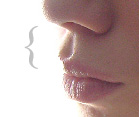Philtrum
As philtrum (also Philtron , neuter; of . Greek φίλτρον Philtron " love magic ") in which is Anatomy the vertical channel designated, extending from the nose to the middle of the upper lip pulls down. It is created during embryonic development when the skin of the face grows together . The lower portion of the philtrum is part of Cupid's arch .
Diagnostic signs
In children with alcohol embryopathy , a flattening of the philtrum can occur , in patients with Wolf-Hirschhorn syndrome a shortening of the philtrum. Children with Williams-Beuren syndrome , trisomy 14 or Peters-Plus syndrome often have a very pronounced, long philtrum.
Facial Diagnostics in Traditional Chinese Medicine
The philtrum is used in traditional Chinese medicine in facial diagnostics. The philtrum can be divided into three parts: the tip of the philtrum, closest to the nose, is the period of childhood. The middle of the philtrum is considered the middle of life, and the lower part characterizes age. Above the nose receives the cosmic qi from the breath through the nostrils and below the mouth the qi receives the earth as food. It is also the place from which fertility can be read and the ability to create artistic projects that arise from the spirit. In physiognomy we see the philtrum as the center of all openings: Above are the three Yang openings , nose, eyes and ears, and below the three Yin openings are the mouth and the two lower openings.
Others
In ancient Greece , the philtrum was considered to be one of the most erogenous points on the body.
Jewelry pierced through the philtrum is known as a Medusa piercing .
See also
Web links
Individual evidence
- ^ Philtrum , DocCheck Flexion
- ^ Lillian Bridges: Face Reading in Chinese Medicine - E-Book . Elsevier Health Sciences, July 10, 2012, ISBN 0-7020-5192-6 , pp. 37-.
